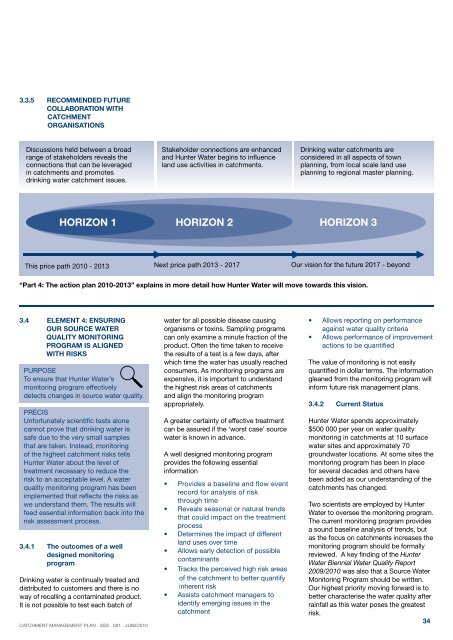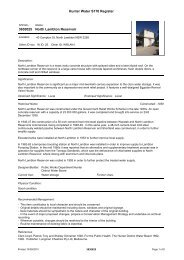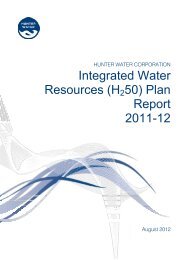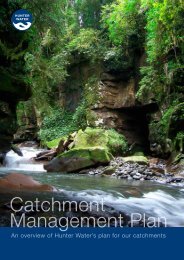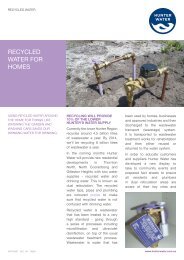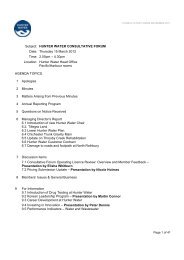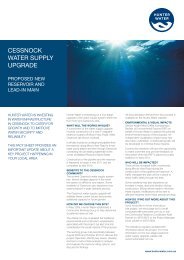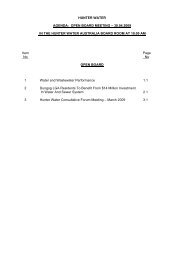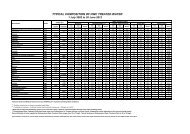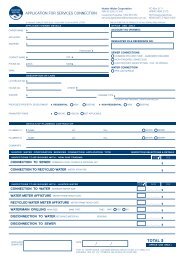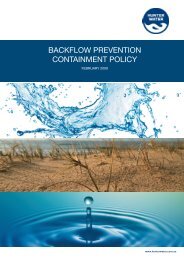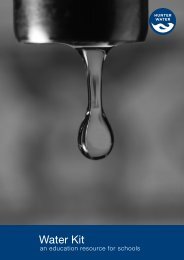Catchment Management Plan - Hunter Water
Catchment Management Plan - Hunter Water
Catchment Management Plan - Hunter Water
Create successful ePaper yourself
Turn your PDF publications into a flip-book with our unique Google optimized e-Paper software.
3.3.5 Recommended futurecollaboration withcatchmentorganisationsDiscussions held between a broadrange of stakeholders reveals theconnections that can be leveragedin catchments and promotesdrinking water catchment issues.Stakeholder connections are enhancedand <strong>Hunter</strong> <strong>Water</strong> begins to influenceland use activities in catchments.Drinking water catchments areconsidered in all aspects of townplanning, from local scale land useplanning to regional master planning.HORIZON 1 HORIZON 2 HORIZON 3►This price path 2010 - 2013 Next price path 2013 - 2017 Our vision for the future 2017 - beyond►►“Part 4: The action plan 2010-2013” explains in more detail how <strong>Hunter</strong> <strong>Water</strong> will move towards this vision.3.4 Element 4: Ensuringour source waterquality monitoringprogram is alignedwith risksPurposeTo ensure that <strong>Hunter</strong> <strong>Water</strong>’smonitoring program effectivelydetects changes in source water quality.PrécisUnfortunately scientific tests alonecannot prove that drinking water issafe due to the very small samplesthat are taken. Instead, monitoringof the highest catchment risks tells<strong>Hunter</strong> <strong>Water</strong> about the level oftreatment necessary to reduce therisk to an acceptable level. A waterquality monitoring program has beenimplemented that reflects the risks aswe understand them. The results willfeed essential information back into therisk assessment process.3.4.1 The outcomes of a welldesigned monitoringprogramDrinking water is continually treated anddistributed to customers and there is noway of recalling a contaminated product.It is not possible to test each batch ofCATCHMENT MANAGEMENT PLAN . ssS . 001 . JUNE2010water for all possible disease causingorganisms or toxins. Sampling programscan only examine a minute fraction of theproduct. Often the time taken to receivethe results of a test is a few days, afterwhich time the water has usually reachedconsumers. As monitoring programs areexpensive, it is important to understandthe highest risk areas of catchmentsand align the monitoring programappropriately.A greater certainty of effective treatmentcan be assured if the ‘worst case’ sourcewater is known in advance.A well designed monitoring programprovides the following essentialinformation• Provides a baseline and flow eventrecord for analysis of riskthrough time• Reveals seasonal or natural trendsthat could impact on the treatmentprocess• Determines the impact of differentland uses over time• Allows early detection of possiblecontaminants• Tracks the perceived high risk areasof the catchment to better quantifyinherent risk• Assists catchment managers toidentify emerging issues in thecatchment• Allows reporting on performanceagainst water quality criteria• Allows performance of improvementactions to be quantifiedThe value of monitoring is not easilyquantified in dollar terms. The informationgleaned from the monitoring program willinform future risk management plans.3.4.2 Current Status<strong>Hunter</strong> <strong>Water</strong> spends approximately$500 000 per year on water qualitymonitoring in catchments at 10 surfacewater sites and approximately 70groundwater locations. At some sites themonitoring program has been in placefor several decades and others havebeen added as our understanding of thecatchments has changed.Two scientists are employed by <strong>Hunter</strong><strong>Water</strong> to oversee the monitoring program.The current monitoring program providesa sound baseline analysis of trends, butas the focus on catchments increases themonitoring program should be formallyreviewed. A key finding of the <strong>Hunter</strong><strong>Water</strong> Biennial <strong>Water</strong> Quality Report2009/2010 was also that a Source <strong>Water</strong>Monitoring Program should be written.Our highest priority moving forward is tobetter characterise the water quality afterrainfall as this water poses the greatestrisk.34


